mirror of
https://github.com/SpaceVim/SpaceVim.git
synced 2025-01-24 06:30:03 +08:00
288 lines
13 KiB
Markdown
288 lines
13 KiB
Markdown
|
|
__
|
|||
|
|
/ /_ ____ ____
|
|||
|
|
/ __ \/ __ \/ __ \
|
|||
|
|
/ / / / /_/ / /_/ /
|
|||
|
|
/_/ /_/\____/ .___/
|
|||
|
|
/_/
|
|||
|
|
· Neovim motions on speed! ·
|
|||
|
|
|
|||
|
|
[](https://matrix.to/#/#hop.nvim:matrix.org)
|
|||
|
|
|
|||
|
|
**Hop** is an [EasyMotion]-like plugin allowing you to jump anywhere in a
|
|||
|
|
document with as few keystrokes as possible. It does so by annotating text in
|
|||
|
|
your buffer with hints, short string sequences for which each character
|
|||
|
|
represents a key to type to jump to the annotated text. Most of the time,
|
|||
|
|
those sequences’ lengths will be between 1 to 3 characters, making every jump
|
|||
|
|
target in your document reachable in a few keystrokes.
|
|||
|
|
|
|||
|
|
<!-- vim-markdown-toc GFM -->
|
|||
|
|
|
|||
|
|
* [Motivation](#motivation)
|
|||
|
|
* [Features](#features)
|
|||
|
|
* [Word mode (`:HopWord`)](#word-mode-hopword)
|
|||
|
|
* [Line mode (`:HopLine`)](#line-mode-hopline)
|
|||
|
|
* [1-char mode (`:HopChar1`)](#1-char-mode-hopchar1)
|
|||
|
|
* [2-char mode (`:HopChar2`)](#2-char-mode-hopchar2)
|
|||
|
|
* [Pattern mode (`:HopPattern`)](#pattern-mode-hoppattern)
|
|||
|
|
* [Visual extend](#visual-extend)
|
|||
|
|
* [Jump on sole occurrence](#jump-on-sole-occurrence)
|
|||
|
|
* [Use as operator motion](#use-as-operator-motion)
|
|||
|
|
* [Inclusive / exclusive motion](#inclusive--exclusive-motion)
|
|||
|
|
* [Getting started](#getting-started)
|
|||
|
|
* [Installation](#installation)
|
|||
|
|
* [Important note about versioning](#important-note-about-versioning)
|
|||
|
|
* [Using vim-plug](#using-vim-plug)
|
|||
|
|
* [Using packer](#using-packer)
|
|||
|
|
* [Nightly users](#nightly-users)
|
|||
|
|
* [Usage](#usage)
|
|||
|
|
* [Keybindings](#keybindings)
|
|||
|
|
* [Configuration](#configuration)
|
|||
|
|
* [Extension](#extension)
|
|||
|
|
* [Chat](#chat)
|
|||
|
|
|
|||
|
|
<!-- vim-markdown-toc -->
|
|||
|
|
|
|||
|
|
# Motivation
|
|||
|
|
|
|||
|
|
**Hop** is a complete from-scratch rewrite of [EasyMotion], a famous plugin to
|
|||
|
|
enhance the native motions of Vim. Even though [EasyMotion] is usable in
|
|||
|
|
Neovim, it suffers from a few drawbacks making it not comfortable to use with
|
|||
|
|
Neovim version >0.5 – at least at the time of writing these lines:
|
|||
|
|
|
|||
|
|
- [EasyMotion] uses an old trick to annotate jump targets by saving the
|
|||
|
|
contents of the buffer, replacing it with the highlighted annotations and
|
|||
|
|
then restoring the initial buffer after jump. This trick is dangerous as it
|
|||
|
|
will change the contents of your buffer. A UI plugin should never do anything
|
|||
|
|
to existing buffers’ contents.
|
|||
|
|
- Because the contents of buffers will temporarily change, other parts of the
|
|||
|
|
editor and/or plugins relying on buffer change events will react and will go
|
|||
|
|
mad. An example is the internal LSP client implementation of Neovim >0.5 or
|
|||
|
|
its treesitter native implementation. For LSP, it means that the connected
|
|||
|
|
LSP server will receive a buffer with the jump target annotations… not
|
|||
|
|
ideal.
|
|||
|
|
|
|||
|
|
**Hop** is a modern take implementing this concept for the latest versions of
|
|||
|
|
Neovim.
|
|||
|
|
|
|||
|
|
# Features
|
|||
|
|
|
|||
|
|
- [x] Go to any word in the current buffer.
|
|||
|
|
- [x] Go to any character in the current buffer.
|
|||
|
|
- [x] Go to any bigrams in the current buffer.
|
|||
|
|
- [x] Use Hop cross windows with multi-windows support.
|
|||
|
|
- [x] Make an arbitrary search akin to <kbd>/</kbd> and go to any occurrences.
|
|||
|
|
- [x] Go to any line.
|
|||
|
|
- [x] Visual extend mode, which allows you to extend a visual selection by hopping elsewhere in the document.
|
|||
|
|
- [x] Use it with commands like `d`, `c`, `y` to delete/change/yank up to your new cursor position.
|
|||
|
|
- [x] Support a wide variety of user configuration options, among the possibility to alter the behavior of commands
|
|||
|
|
to hint only before or after the cursor, for the current line, change the dictionary keys to use for the labels,
|
|||
|
|
jump on sole occurrence, etc.
|
|||
|
|
- [x] Extensible: provide your own jump targets and create Hop extensions!
|
|||
|
|
|
|||
|
|
## Word mode (`:HopWord`)
|
|||
|
|
|
|||
|
|
This mode highlights all the recognized words in the visible part of the buffer and allows you to jump to any.
|
|||
|
|
|
|||
|
|
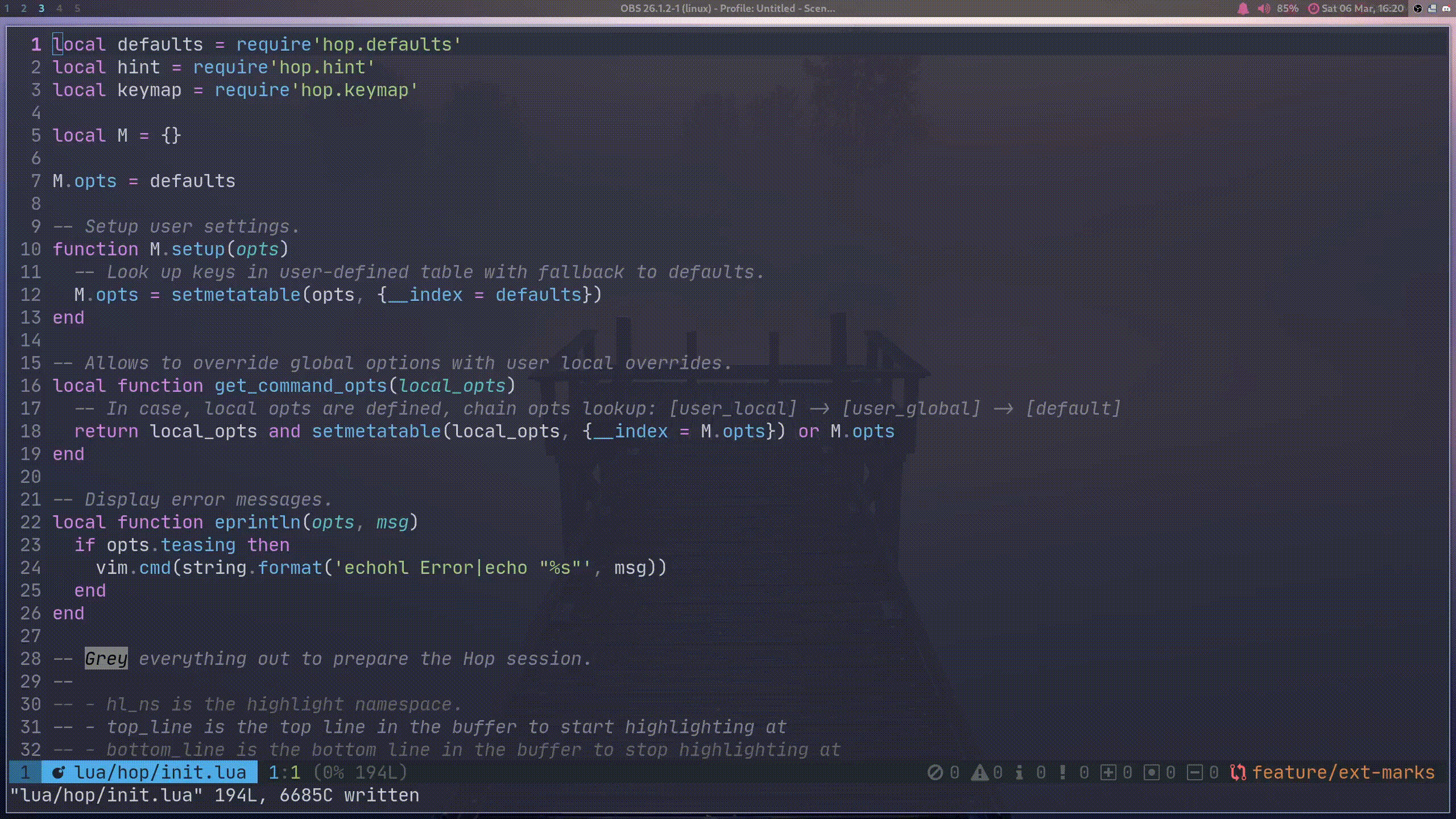
|
|||
|
|
|
|||
|
|
## Line mode (`:HopLine`)
|
|||
|
|
|
|||
|
|
This mode highlights the beginnings of each line in the visible part of the buffer for quick line hopping.
|
|||
|
|
|
|||
|
|
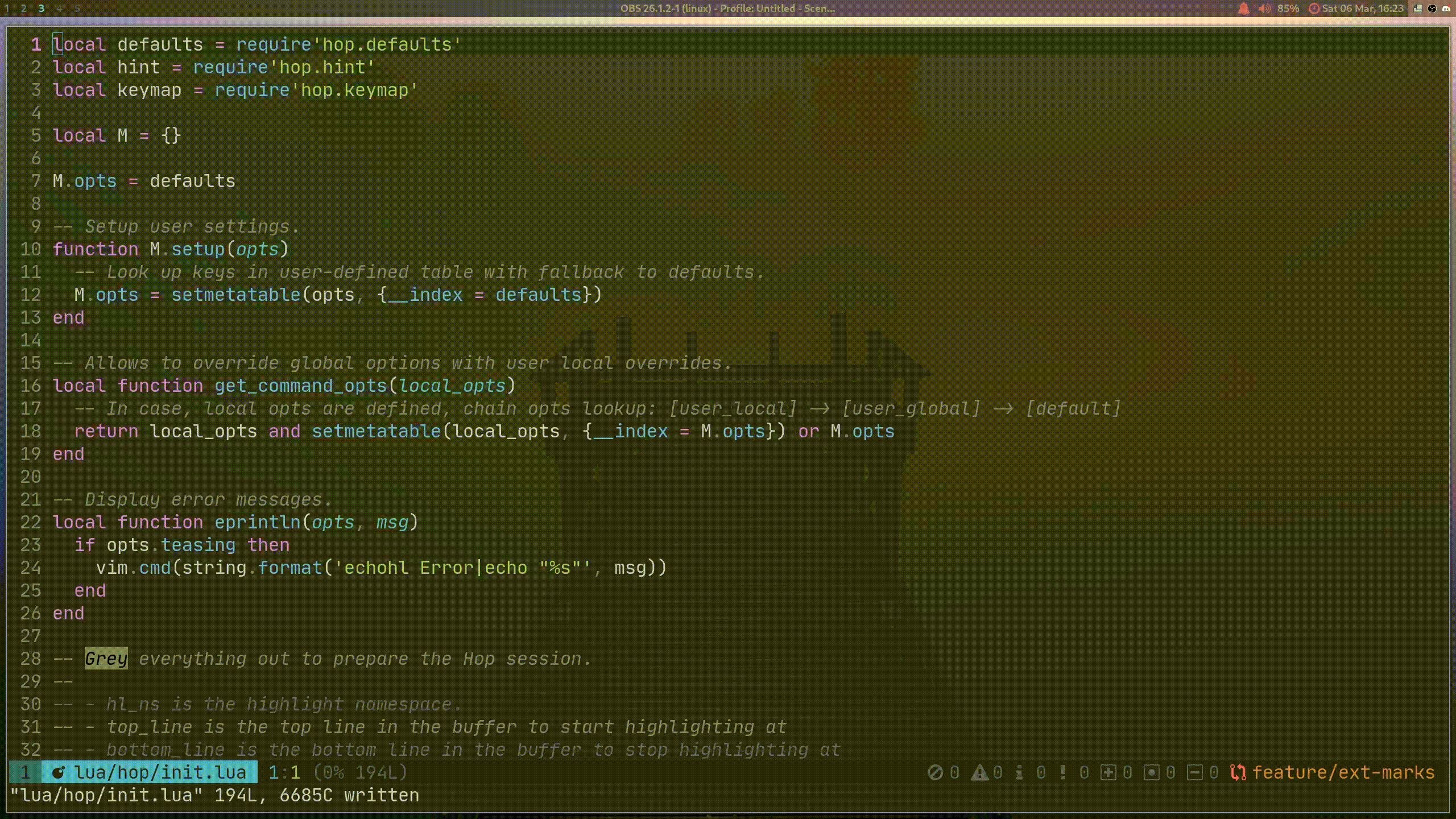
|
|||
|
|
|
|||
|
|
## 1-char mode (`:HopChar1`)
|
|||
|
|
|
|||
|
|
This mode expects the user to type a single character. That character will then be highlighted in the visible part of
|
|||
|
|
the buffer, allowing to jump to any of its occurrence. This mode is especially useful to jump to operators, punctuations
|
|||
|
|
or any symbols not recognized as parts of words.
|
|||
|
|
|
|||
|
|
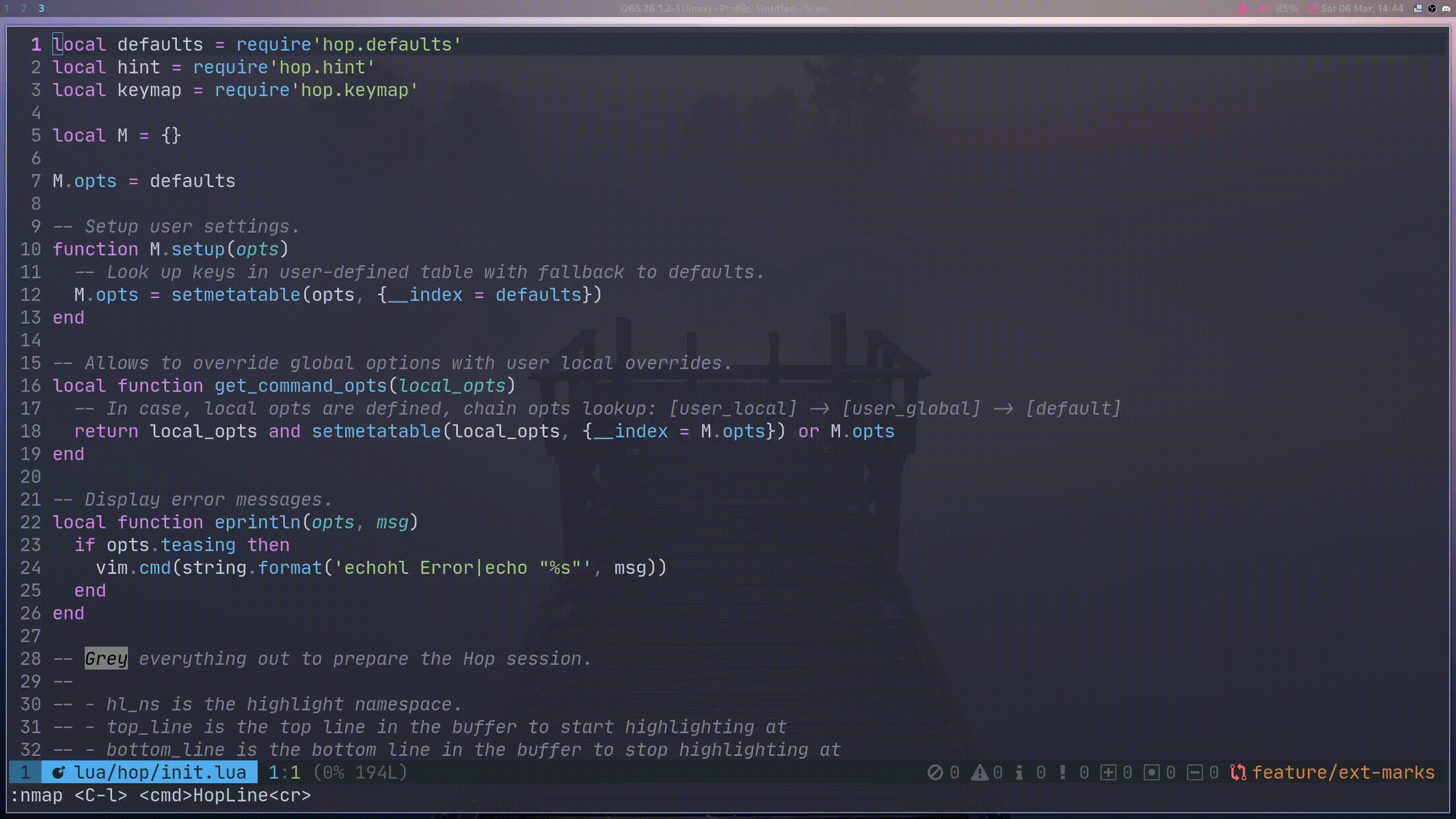
|
|||
|
|
|
|||
|
|
## 2-char mode (`:HopChar2`)
|
|||
|
|
|
|||
|
|
A variant of the 1-char mode, this mode exacts the user to type two characters, representing a _bigram_ (they follow
|
|||
|
|
each other, in order). The bigram occurrences in the visible part of the buffer will then be highlighted for you to jump
|
|||
|
|
to any.
|
|||
|
|
|
|||
|
|
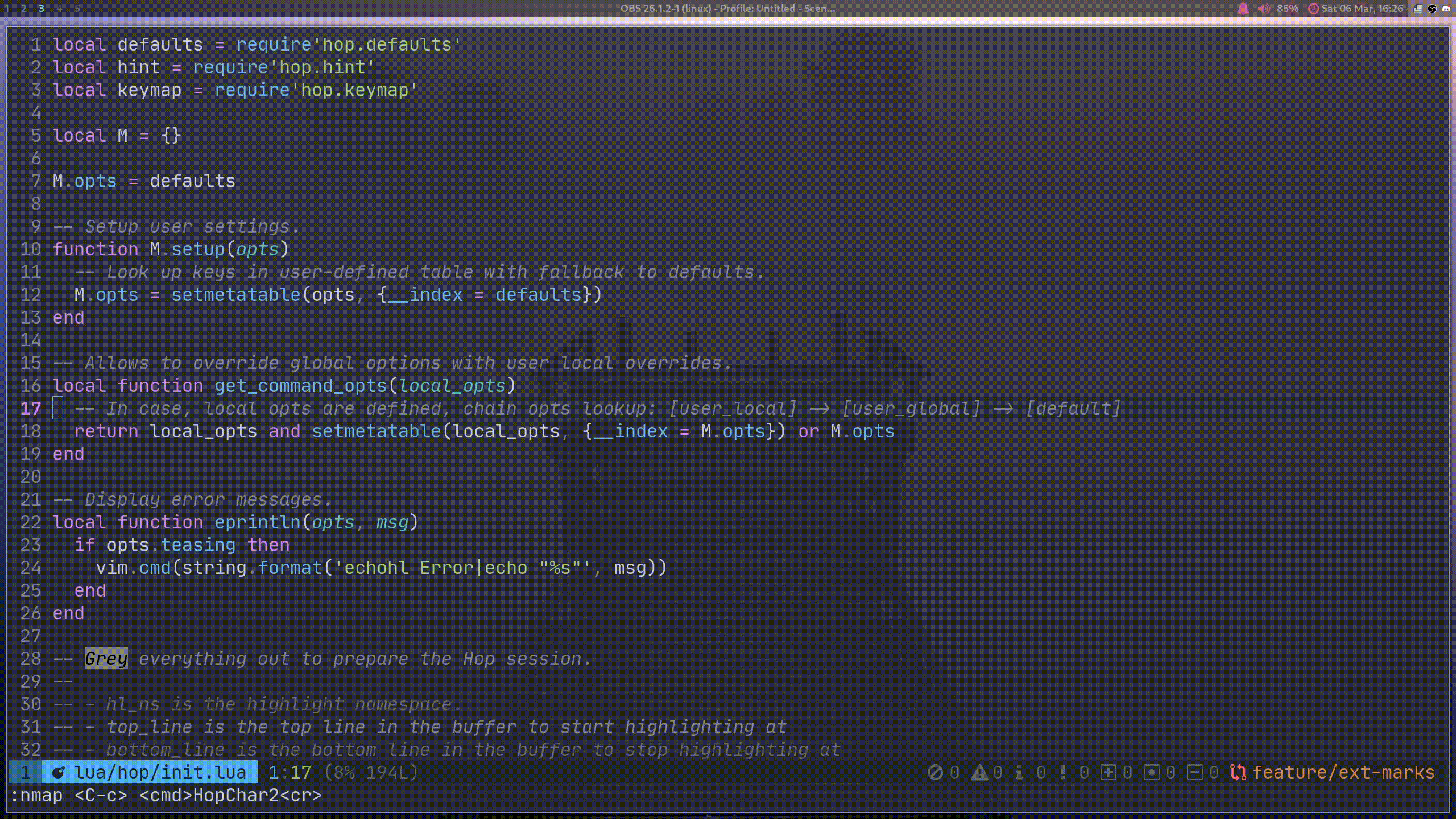
|
|||
|
|
|
|||
|
|
Note that it’s possible to _fallback to 1-char mode_ if you hit a special key as second key. This key can be controlled
|
|||
|
|
via the user configuration. `:h hop-config-char2_fallback_key`.
|
|||
|
|
|
|||
|
|
## Pattern mode (`:HopPattern`)
|
|||
|
|
|
|||
|
|
Akin to `/`, this mode prompts you for a pattern (regex) to search. Occurrences will be highlighted, allowing you to
|
|||
|
|
jump to any.
|
|||
|
|
|
|||
|
|
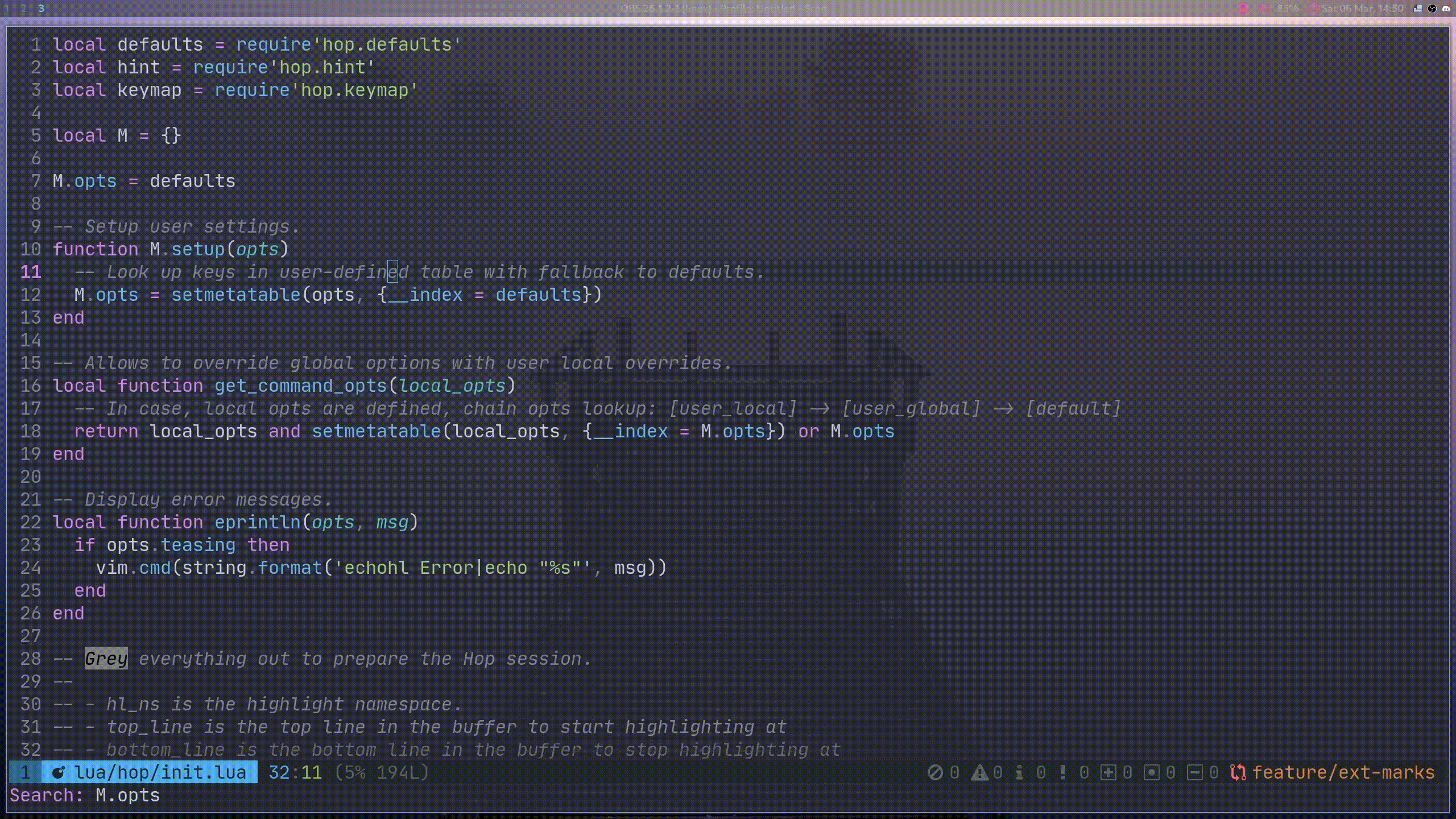
|
|||
|
|
|
|||
|
|
## Visual extend
|
|||
|
|
|
|||
|
|
If you call any Hop commands / Lua functions from one of the visual modes, the visual selection will be extended.
|
|||
|
|
|
|||
|
|
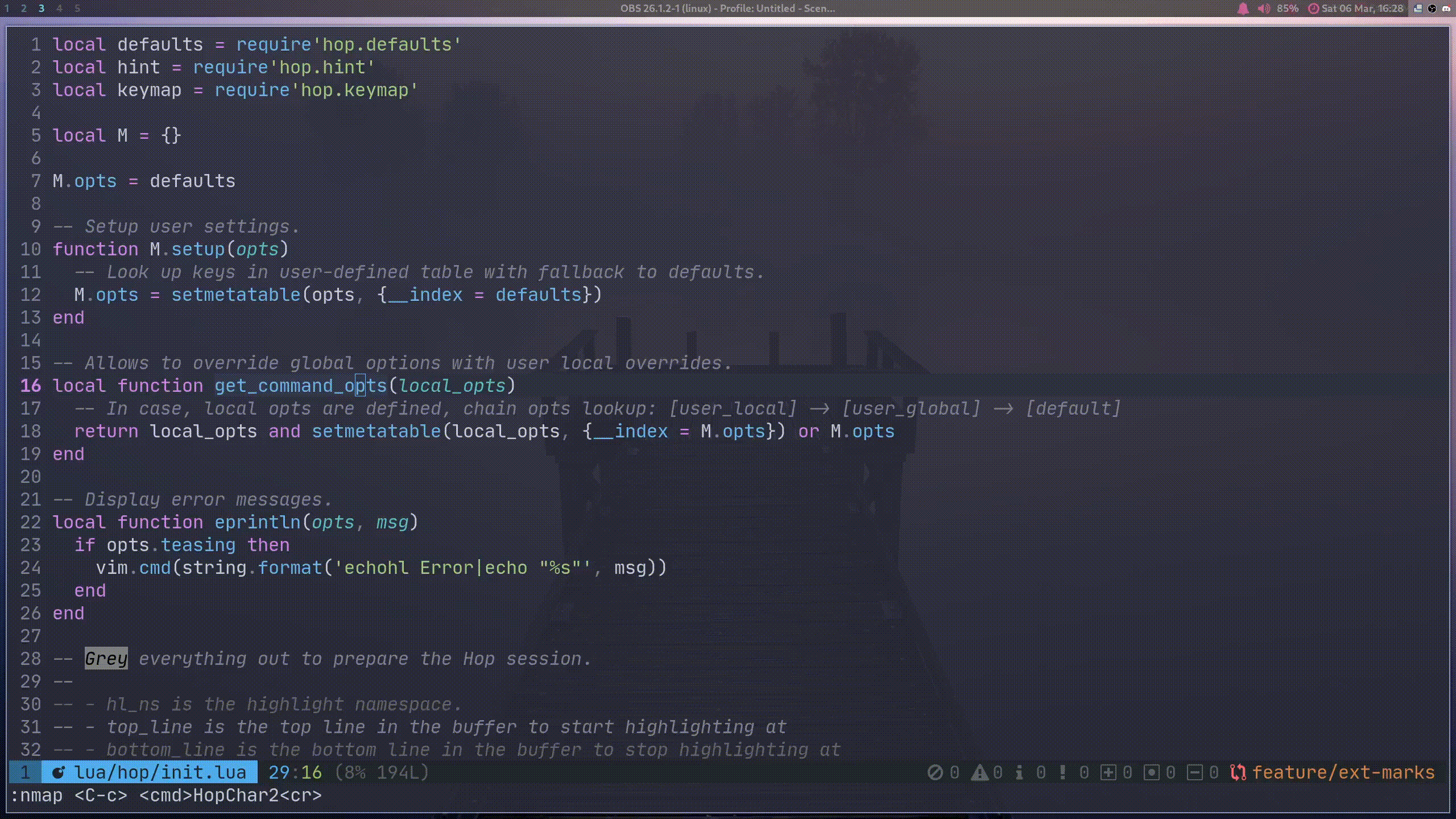
|
|||
|
|
|
|||
|
|
## Jump on sole occurrence
|
|||
|
|
|
|||
|
|
If only a single occurrence is visible in the buffer, Hop will automatically jump to it without requiring pressing any
|
|||
|
|
extra key.
|
|||
|
|
|
|||
|
|
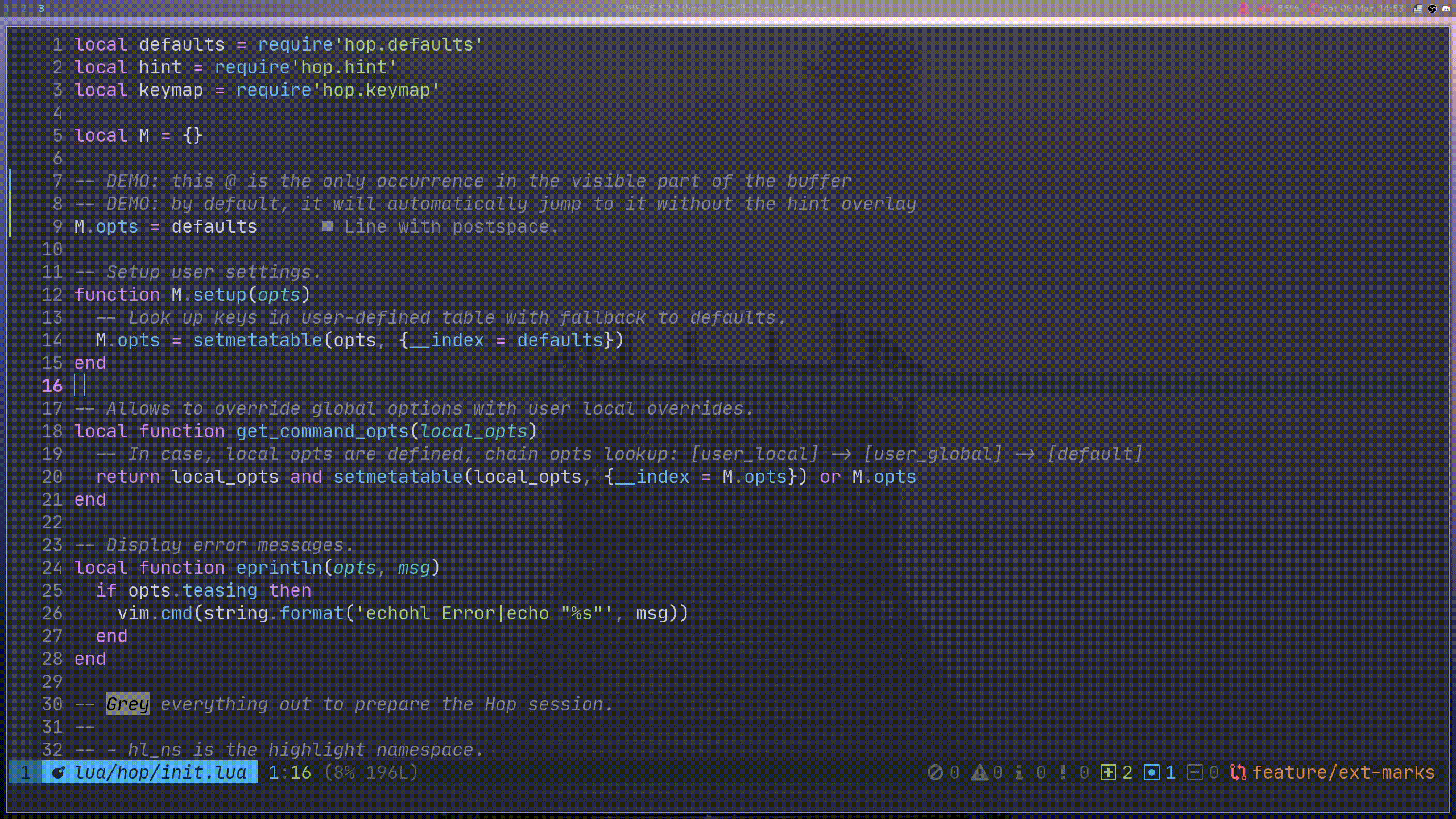
|
|||
|
|
|
|||
|
|
## Use as operator motion
|
|||
|
|
|
|||
|
|
You can use Hop with any command that expects a motion, such as `d`, `y`, `c`, and it does what you would expect:
|
|||
|
|
Delete/yank/change the document up to the new cursor position.
|
|||
|
|
|
|||
|
|
## Inclusive / exclusive motion
|
|||
|
|
|
|||
|
|
By default, Hop will operate in exclusive mode, which is similar to what you get with `t`: deleting from the cursor
|
|||
|
|
position up to the next `)` (without deleting the `)`), which is normally done with `dt)`. However, if you want to be
|
|||
|
|
inclusive (i.e. delete the `)`, which is `df)` in vanilla), you can set the `inclusive_jump` option to `true`.
|
|||
|
|
|
|||
|
|
Some limitations currently exist, requiring `virtualedit` special settings. `:h hop-config-inclusive_jump` for more
|
|||
|
|
information.
|
|||
|
|
|
|||
|
|
# Getting started
|
|||
|
|
|
|||
|
|
This section will guide you through the list of steps you must take to be able to get started with **Hop**.
|
|||
|
|
|
|||
|
|
This plugin was written against Neovim 0.5, which is currently a nightly version. This plugin will not work:
|
|||
|
|
|
|||
|
|
- With a version of Neovim before 0.5.
|
|||
|
|
- On Vim. **No support for Vim is planned.**
|
|||
|
|
|
|||
|
|
## Installation
|
|||
|
|
|
|||
|
|
Whatever solution / package manager you are using, you need to ensure that the `setup` Lua function is called at some
|
|||
|
|
point, otherwise the plugin will not work. If your package manager doesn’t support automatic calling of this function,
|
|||
|
|
you can call it manually after your plugin is installed:
|
|||
|
|
|
|||
|
|
```lua
|
|||
|
|
require'hop'.setup()
|
|||
|
|
```
|
|||
|
|
|
|||
|
|
To get a default experience. Feel free to customize later the `setup` invocation (`:h hop.setup`). If you do, then you
|
|||
|
|
will probably want to ensure the configuration is okay by running `:checkhealth`. Various checks will be performed by
|
|||
|
|
Hop to ensure everything is all good.
|
|||
|
|
|
|||
|
|
### Important note about versioning
|
|||
|
|
|
|||
|
|
This plugin implements [SemVer] via git branches and tags. Versions are prefixed with a `v`, and only patch versions
|
|||
|
|
are git tags. Major and minor versions are git branches. You are **very strongly advised** to use a major version
|
|||
|
|
dependency to be sure your config will not break when Hop gets updated.
|
|||
|
|
|
|||
|
|
### Using vim-plug
|
|||
|
|
|
|||
|
|
```vim
|
|||
|
|
Plug 'phaazon/hop.nvim'
|
|||
|
|
```
|
|||
|
|
|
|||
|
|
### Using packer
|
|||
|
|
|
|||
|
|
```lua
|
|||
|
|
use {
|
|||
|
|
'phaazon/hop.nvim',
|
|||
|
|
branch = 'v1', -- optional but strongly recommended
|
|||
|
|
config = function()
|
|||
|
|
-- you can configure Hop the way you like here; see :h hop-config
|
|||
|
|
require'hop'.setup { keys = 'etovxqpdygfblzhckisuran' }
|
|||
|
|
end
|
|||
|
|
}
|
|||
|
|
```
|
|||
|
|
|
|||
|
|
### Nightly users
|
|||
|
|
|
|||
|
|
Hop supports nightly releases of Neovim. However, keep in mind that if you are on a nightly version, you must be **on
|
|||
|
|
the last one**. If you are not, then you are exposed to compatibility issues / breakage.
|
|||
|
|
|
|||
|
|
# Usage
|
|||
|
|
|
|||
|
|
A bunch of vim commands are available to get your fingers wrapped around **Hop** quickly:
|
|||
|
|
|
|||
|
|
- `:HopWord`: hop around by highlighting words.
|
|||
|
|
- `:HopPattern`: hop around by matching against a pattern (as with `/`).
|
|||
|
|
- `:HopChar1`: type a single key and hop to any occurrence of that key in the document.
|
|||
|
|
- `:HopChar2`: type a bigram (two keys) and hop to any occurrence of that bigram in the document.
|
|||
|
|
- `:HopLine`: jump to any visible line in your buffer.
|
|||
|
|
- `:HopLineStart`: jump to any visible first non-whitespace character of each line in your buffer.
|
|||
|
|
|
|||
|
|
Most of these commands have variant to jump before / after the cursor, and on the current line. For instance,
|
|||
|
|
`:HopChar1CurrentLineAC` is a form of `f` (Vim native motion) using Hop.
|
|||
|
|
|
|||
|
|
If you would rather use the Lua API, you can test it via the command prompt:
|
|||
|
|
|
|||
|
|
```vim
|
|||
|
|
:lua require'hop'.hint_words()
|
|||
|
|
```
|
|||
|
|
|
|||
|
|
For a more complete user guide and help pages:
|
|||
|
|
|
|||
|
|
```vim
|
|||
|
|
:help hop
|
|||
|
|
```
|
|||
|
|
|
|||
|
|
# Keybindings
|
|||
|
|
|
|||
|
|
Hop doesn’t set any keybindings; you will have to define them by yourself.
|
|||
|
|
|
|||
|
|
If you want to create a key binding from within Lua:
|
|||
|
|
|
|||
|
|
```lua
|
|||
|
|
-- place this in one of your configuration file(s)
|
|||
|
|
vim.api.nvim_set_keymap('n', 'f', "<cmd>lua require'hop'.hint_char1({ direction = require'hop.hint'.HintDirection.AFTER_CURSOR, current_line_only = true })<cr>", {})
|
|||
|
|
vim.api.nvim_set_keymap('n', 'F', "<cmd>lua require'hop'.hint_char1({ direction = require'hop.hint'.HintDirection.BEFORE_CURSOR, current_line_only = true })<cr>", {})
|
|||
|
|
vim.api.nvim_set_keymap('o', 'f', "<cmd>lua require'hop'.hint_char1({ direction = require'hop.hint'.HintDirection.AFTER_CURSOR, current_line_only = true, inclusive_jump = true })<cr>", {})
|
|||
|
|
vim.api.nvim_set_keymap('o', 'F', "<cmd>lua require'hop'.hint_char1({ direction = require'hop.hint'.HintDirection.BEFORE_CURSOR, current_line_only = true, inclusive_jump = true })<cr>", {})
|
|||
|
|
vim.api.nvim_set_keymap('', 't', "<cmd>lua require'hop'.hint_char1({ direction = require'hop.hint'.HintDirection.AFTER_CURSOR, current_line_only = true })<cr>", {})
|
|||
|
|
vim.api.nvim_set_keymap('', 'T', "<cmd>lua require'hop'.hint_char1({ direction = require'hop.hint'.HintDirection.BEFORE_CURSOR, current_line_only = true })<cr>", {})
|
|||
|
|
vim.api.nvim_set_keymap('n', '<leader>e', "<cmd> lua require'hop'.hint_words({ hint_position = require'hop.hint'.HintPosition.END })<cr>", {})
|
|||
|
|
vim.api.nvim_set_keymap('v', '<leader>e', "<cmd> lua require'hop'.hint_words({ hint_position = require'hop.hint'.HintPosition.END })<cr>", {})
|
|||
|
|
vim.api.nvim_set_keymap('o', '<leader>e', "<cmd> lua require'hop'.hint_words({ hint_position = require'hop.hint'.HintPosition.END, inclusive_jump = true })<cr>", {})
|
|||
|
|
```
|
|||
|
|
|
|||
|
|
# Configuration
|
|||
|
|
|
|||
|
|
You can configure Hop via several different mechanisms:
|
|||
|
|
|
|||
|
|
- _Global configuration_ uses the Lua `setup` API (`:h hop.setup`). This allows you to setup global options that will be
|
|||
|
|
used by all Hop Lua functions as well as the vim commands (e.g. `:HopWord`). This is the easiest way to configure Hop
|
|||
|
|
on a global scale. You can do this in your `init.lua` or any `.vim` file by using the `lua` vim command.
|
|||
|
|
Example:
|
|||
|
|
```vim
|
|||
|
|
" init.vim
|
|||
|
|
"
|
|||
|
|
" Use better keys for the bépo keyboard layout and set
|
|||
|
|
" a balanced distribution of terminal / sequence keys
|
|||
|
|
lua require'hop'.setup { keys = 'etovxqpdygfblzhckisuran', jump_on_sole_occurrence = false }
|
|||
|
|
```
|
|||
|
|
- _Local configuration overrides_ are available only on the Lua API and are `{opts}` Lua tables passed to the various
|
|||
|
|
Lua functions. Those options have precedence over global options, so they allow to locally override options. Useful if
|
|||
|
|
you want to test a special option for a single Lua function, such as `require'hop'.hint_lines()`. You can test them
|
|||
|
|
inside the command line, such as:
|
|||
|
|
```
|
|||
|
|
:lua require'hop'.hint_words({ direction = require'hop.hint'.HintDirection.BEFORE_CURSOR })
|
|||
|
|
```
|
|||
|
|
- In the case of none of the above are provided, options are automatically read from the _default_ options. See `:h
|
|||
|
|
hop-config` for a list of default values.
|
|||
|
|
|
|||
|
|
# Extension
|
|||
|
|
|
|||
|
|
It is possible to extend Hop by creating *Hop extension plugins*. For more info:
|
|||
|
|
|
|||
|
|
```vim
|
|||
|
|
:h hop-extension
|
|||
|
|
```
|
|||
|
|
|
|||
|
|
> Disclaimer: you may have written a nice Hop extension plugin. You can open an issue to merge it upstream but remember
|
|||
|
|
> that it’s unlikely to be merged as Hop should remain small and straight-to-the point.
|
|||
|
|
|
|||
|
|
# Chat
|
|||
|
|
|
|||
|
|
Join the discussion on the official [Matrix room](https://matrix.to/#/#hop.nvim:matrix.org)!
|
|||
|
|
|
|||
|
|
[EasyMotion]: https://github.com/easymotion/vim-easymotion
|
|||
|
|
[packer]: https://github.com/wbthomason/packer.nvim
|
|||
|
|
[SemVer]: https://semver.org
|